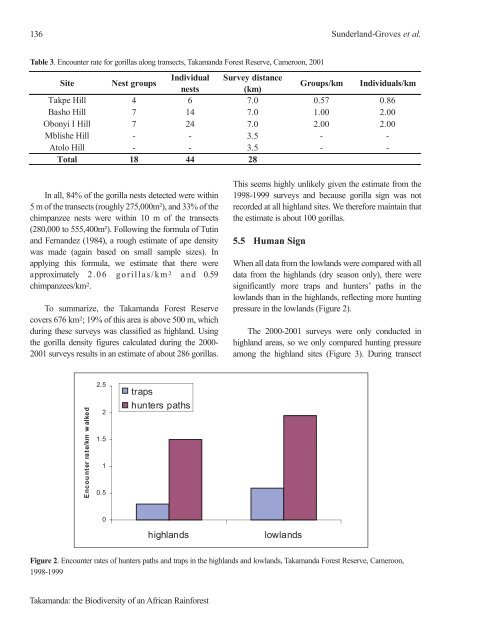Fisheries in the Southern Border Zone of Takamanda - Impact ...
Fisheries in the Southern Border Zone of Takamanda - Impact ...
Fisheries in the Southern Border Zone of Takamanda - Impact ...
You also want an ePaper? Increase the reach of your titles
YUMPU automatically turns print PDFs into web optimized ePapers that Google loves.
136 Sunderland-Groves et al.<br />
Table 3. Encounter rate for gorillas along transects, <strong>Takamanda</strong> Forest Reserve, Cameroon, 2001<br />
Site Nest groups<br />
Individual<br />
nests<br />
Survey distance<br />
(km)<br />
Groups/km Individuals/km<br />
Takpe Hill 4 6 7.0 0.57 0.86<br />
Basho Hill 7 14 7.0 1.00 2.00<br />
Obonyi I Hill 7 24 7.0 2.00 2.00<br />
Mblishe Hill - - 3.5 - -<br />
Atolo Hill - - 3.5 - -<br />
Total 18 44 28<br />
In all, 84% <strong>of</strong> <strong>the</strong> gorilla nests detected were with<strong>in</strong><br />
5 m <strong>of</strong> <strong>the</strong> transects (roughly 275,000m²), and 33% <strong>of</strong> <strong>the</strong><br />
chimpanzee nests were with<strong>in</strong> 10 m <strong>of</strong> <strong>the</strong> transects<br />
(280,000 to 555,400m²). Follow<strong>in</strong>g <strong>the</strong> formula <strong>of</strong> Tut<strong>in</strong><br />
and Fernandez (1984), a rough estimate <strong>of</strong> ape density<br />
was made (aga<strong>in</strong> based on small sample sizes). In<br />
apply<strong>in</strong>g this formula, we estimate that <strong>the</strong>re were<br />
approximately 2.06 gorillas/km 2 a n d 0.59<br />
chimpanzees/km 2 .<br />
To summarize, <strong>the</strong> <strong>Takamanda</strong> Forest Reserve<br />
covers 676 km 2 ; 19% <strong>of</strong> this area is above 500 m, which<br />
dur<strong>in</strong>g <strong>the</strong>se surveys was classified as highland. Us<strong>in</strong>g<br />
<strong>the</strong> gorilla density figures calculated dur<strong>in</strong>g <strong>the</strong> 2000-<br />
2001 surveys results <strong>in</strong> an estimate <strong>of</strong> about 286 gorillas.<br />
Encounter rate/km walked<br />
2.5<br />
2<br />
1.5<br />
1<br />
0.5<br />
0<br />
traps<br />
hunters paths<br />
<strong>Takamanda</strong>: <strong>the</strong> Biodiversity <strong>of</strong> an African Ra<strong>in</strong>forest<br />
This seems highly unlikely given <strong>the</strong> estimate from <strong>the</strong><br />
1998-1999 surveys and because gorilla sign was not<br />
recorded at all highland sites. We <strong>the</strong>refore ma<strong>in</strong>ta<strong>in</strong> that<br />
<strong>the</strong> estimate is about 100 gorillas.<br />
5.5 Human Sign<br />
highlands lowlands<br />
When all data from <strong>the</strong> lowlands were compared with all<br />
data from <strong>the</strong> highlands (dry season only), <strong>the</strong>re were<br />
significantly more traps and hunters’ paths <strong>in</strong> <strong>the</strong><br />
lowlands than <strong>in</strong> <strong>the</strong> highlands, reflect<strong>in</strong>g more hunt<strong>in</strong>g<br />
pressure <strong>in</strong> <strong>the</strong> lowlands (Figure 2).<br />
The 2000-2001 surveys were only conducted <strong>in</strong><br />
highland areas, so we only compared hunt<strong>in</strong>g pressure<br />
among <strong>the</strong> highland sites (Figure 3). Dur<strong>in</strong>g transect<br />
Figure 2. Encounter rates <strong>of</strong> hunters paths and traps <strong>in</strong> <strong>the</strong> highlands and lowlands, <strong>Takamanda</strong> Forest Reserve, Cameroon,<br />
1998-1999

















